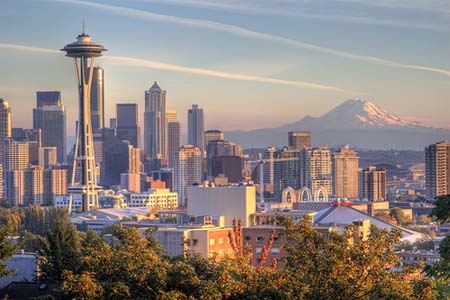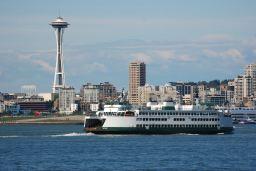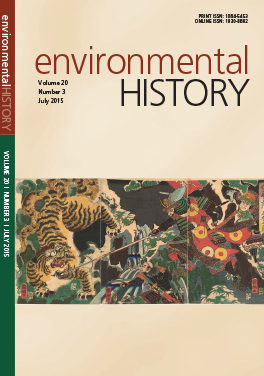|
|
 | |
aseh news
summer 2015 volume 26, issue 2
|
|
environmental history and its publics: update on Seattle conference 2016
|
 Proposals for panels, roundtables, and posters are due July 8, 2015. Click here for more info. Dates of conference: March 30 - April 3, 2016 Location: Westin Hotel, downtown Seattle
T o reserve a room at the hotel, and for additional conference info., click here. The hotel rate is $159/night, and there are a limited number of discounted rooms available for students.Our 2016 conference will include the following events:
- workshop on publishing, sponsored by University of Washington Press, March 30
- FHS lunch talk by Douglas Brinkley, March 31
- evening plenary session on teaching and environmental history, March 31
- evening plenary session on water and drought, April 2
- four walking tours of dowtown Seattle
- field trip to Snoqualmie Falls Hydroelectric Plant
- field trips to several national parks in Seattle area
- large exhibit area including a rotating professionals table highlighting environmental history careers
- 100 sessions
|
| |
Snoqualmie Falls Hydroelectric Plant (built in 1898), Friday afternoon trip, April 1
|
|
|
| |
Elwha Dam Removal, Olympic Peninsula, day trip, April 3
|
|
|
| |
Ebey's Landing National Historical Reserve, day trip, April 3
|
|
| |
Discovery Park birding trip, April 1
|
|
|
| |
Bullitt Center Green Building tour, April 1
|
| |
|
|
| |
Detail from Arctic Building, downtown Seattle
|
| |
Photos courtesy Visit Seattle and Lisa Mighetto.
| |
|
|
travel grants
| |
A limited number of travel grants will be available for students and low-income scholars presenting at our 2016 conference. Once the program committee selects the sessions and creates the program, we will contact presenters will more info., including how to apply. 
|
|
future conferences
|
March 30-April 3, 2016
Chicago
March 29-April 2, 2017
If you are interested in submitting a proposal to host a future ASEH conference, contact director@aseh.net for guidelines. ASEH will be selecting our 2018 and 2019 conference sites this fall.
|
|
journal
| |

Click here for info. on the July issue of our journal Environmental History, which includes an article on "Tigers - real and imagined - in Korea's Physical and Cultural Landscape" and more. |
|
have you signed up for aseh's member directory?
| |
ASEH's Digital Communications Committee has created an online directory of members. Any member can register on this new site, which is publicly available to anyone searching for contact info. on environmental historians and their research. The site is open for registration and viewing.
We encourage all ASEH members to register. If you have questions or comments, contact
Click here to register. Thank you for your participation!
|
|
introducing a new interest group
| |
GeoCart is a new group within ASEH that seeks to connect people with interests in the intersections between environmental history and geography or geospatial technologies. For more information see: http://aseh.net/resources/interest-groups/geo-cart or contact Jordan Howell at howellj@rowan.edu. Click here to see a list of ASEH interest groups.
|
|
aseh summer internship
| |
Congratulations to Rachel Jacobson, graduate student at North Carolina State University - recipient of ASEH's summer internship award. She will assist the Smithsonian Conservation Biology Institute on an environmental history archive project.
|
|
aseh news
| |
Published quarterly by the American Society for Environmental History. If you have an article, announcement, or an item for the "member news" section of our next newsletter, send to director@aseh.net by September 11, 2015.
|
|
stay connected
|  
|
|
|
|
|
president's column: climate, drought, and our 2016 conference
After tornadoes and record rainfall, summer arrived in Oklahoma with the first of June. In the summers, Jake the dog and I rise early to walk before the heat of the day sets in. We approach the task with enthusiasm, although after a mile or so, it's a debate as to which one of us is aging more quickly. Our walks give me a chance to contemplate many things. Like one of my predecessors, John McNeill, I wonder when the White Sox will fall out of contention (statistically who knows; in reality July seems likely). At least the Hawks took the Stanley Cup (hurrah!), but there is something incongruous about playing hockey in June yet alone in Florida.
Lately I have been thinking about weather and climate. Four to six weeks of heavy spring rains alleviated the long-term drought in Oklahoma, although the torrents produced severe flooding in many places. There is no relief in sight for the West Coast, however. May precipitation resulted in new vegetation and grasses in southern and eastern portions of California, but long-term hydrologic conditions remain dire. According to the U.S. Drought Monitor, the new vegetation is likely to provide additional wildfire fuel later in the summer.
The California drought, perhaps the worst in 1,200 years, raises important questions for environmental historians regarding climate change and environmental justice. 2014 was the hottest year on record by a large margin. Soaring temperatures undermined the snowpack essential to filling the state's reservoirs while drying out soils. Moreover, researchers at Stanford suggest that climate change contributed to a high-pressure weather pattern which led to significant declines in rainfall over the past four years.
The impacts of the drought have not been experienced equally. In urban areas, wealthy neighborhoods used three times as much water as poorer ones. Governor Jerry Brown issued a mandatory 25-percent cut in water usage in April 2015, but it remains to be seen whether this restriction can undo such discrepancies when some people simply can afford to purchase more water or pay fines.
Of course agriculture uses more water than California's cities. The state remains the nation's largest agricultural producer, but many of its crops fill markets across the country and across the oceans rather than feeding local actors. California farms surprisingly added 6,000 workers in 2014, but this figure did not represent absolute gains. Many farmers shifted toward permanent crops which required more labor; acreage devoted to vegetables, nuts, and grapes increased. Other farmers fallowed a half million acres of wheat, rice, hay and cotton. Consequently, employment patterns varied from region to region and even among farms within a given region.
The issues surrounding the California drought resonate across the globe. Brett Walker and the program committee for our 2016 meeting in Seattle are organizing a timely plenary session on drought. A second special plenary session, featuring Bill Cronon and others, will focus on the importance of undergraduate training in today's higher education climate. We also are developing with the ASEH Diversity Committee a presidential session focused on race and the environment. Field trips will include a salmon tour at Ballard Locks, a green buildings tour, the Snoqualmie Falls Historic District, the Duwamish River cleanup project, a local winery tour, and a ferry ride and visit to Bainbridge Island and the Japanese American Exclusion Memorial.
The deadline for proposals is July 8, 2015. We hope you will join us. Learn more at http://aseh.net/conference-workshops/seattle-conference-2016.
Please send your ideas or concerns to me.
Kathy Brosnan, ASEH President - kbrosnan@ou.edu
|
the profession: Sacramento-San Joaquin Delta Project
by Philip Garone, California State University-Stanislaus
The ASEH has placed an increased - and well warranted - emphasis on encouraging environmental historians to engage multiple publics with our work, and public history projects offer an excellent opportunity to do so. One promising approach is to pursue collaborative grants from state and regional institutions, a fine alternative to more commonly known federal grant programs such as those offered, for example, by the NEH and NSF. This short essay describes a state-funded project undertaken by an interdisciplinary group of scholars and archivists that is directed toward increasing public support for the protection of one of the nation's most threatened regions, California's Sacramento-San Joaquin Delta.
The Delta is the largest estuary on the western coast of the Americas and one of the most ecologically altered landscapes in California. Reclamation projects since California statehood have transformed the Delta from a tidal wetland to an intensively cultivated, highly engineered agricultural landscape. Today, the Delta serves also as the linchpin in California's massive hydraulic infrastructure, yet the region is little known-and even lesser understood-by the vast majority of Californians, making it difficult to muster political support for its protection.
|
| |
This sign greets visitors as they enter the Delta from the four cardinal directions. Photo by author.
|
My colleagues and I therefore developed a proposal for a public history project that would emphasize the Delta's important environmental, agro-economic, cultural, and literary history. The proposal called for the scholars (from CSU Stanislaus, University of the Pacific, and UC Merced) to write narratives on these threads of the Delta's history; the archivists on the project team would help us locate sources in their collections, and would later use our narratives to develop exhibits highlighting the region's multifaceted and complex history. Our subsequent experience points to the importance of both persistence and flexibility in the grant-seeking process. We submitted three increasingly refined versions of the project over three years to the NEH. Despite generally favorable reviews, we were turned down all three times.
However, we then contacted the Executive Director of the California Delta Protection Commission, a state government body. The Commission developed an interest in our project as a way to prepare for a declaration of a National Heritage Area for the Delta Region, and invited us to submit our proposal, titled "Delta Narratives," which they funded for 2014-2015. In the end, we were selected because we had put considerable work into the earlier applications and the Commission appreciated the detailed analysis we had already undertaken; they knew members of our team and had trust in our ability to work with them and to deliver.
The project has been immensely rewarding.
|
| |
Front cover of the 1922-1923
Byron Times, an early 20th-century booster magazine for the Delta. Courtesy of the Haggin Museum and Archive, Stockton, California.
|
Collaborating throughout the year, we have each delved through the Delta's numerous archives and repositories and created monographs on the region's history. In that way, the work was not all that different from traditional academic research. But we also held regular meetings with stakeholders in the region, including local historical societies, museums, libraries, and conservancies, at which we presented our research-in-progress and solicited and received extensive feedback from local experts. In June 2015 we presented our final research at a policy conference in Sacramento, marking the transition point when the project moved forward from the hands of the scholars to the Delta communities and their cultural institutions, which will bring the exhibits to fruition over the next several years.
For further information about the Delta Narratives project, please visit our recently created website at http://www.delta.ca.gov/Delta_Narratives.htm, which will be regularly updated as the project continues.
Philip Garone is an Associate Professor at California State University Stanislaus, where he teaches environmental history. His role in this project is an extension of his work on the Delta that first appeared in his book, The Fall and Rise of the Wetlands of California's Great Central Valley (Berkeley and Los Angeles: University of California Press, 2011).
|
|
member news
Gregory Cushman, University of Kansas, has received a Carnegie Fellowship.
Scott Einberger has published A History of Rock Creek Park: Wilderness and Washington, D.C. (The History Press).
Marcel LaFollette has been working on a blog-post series as way to draw attention to the remarkable Science Service collection at the Smithsonian Institution Archives, and to get some of the collection's photo treasures digitized (photos that would not otherwise be digitized without a researcher's request). See:
http://siarchives.si.edu/blog/science-service-close-save-redwoods
Kieko Matteson, University of Hawaii, has published
Forests in Revolutionary France
Conservation, Community, and Conflict, 1669-1848
(Cambridge University Press).
|
|
announcements
Final Notice - Call for Proposals for ASEH's 2016 Conference in Seattle
Join our 2016 conference in Seattle - proposals for panels, roundtables, and posters are due July 8, 2015. Click here for more information, including the submission form.
ASEH Award Submissions Due
ASEH presents awards for scholarship, service, and achievement. These include prizes for best book, article, dissertation, public outreach project, and more. The deadline for this year's award submissions is November 16, 2015. For a list of awards and instructions on how to submit, click here.
ASEH Fellowship Applications Due The Samuel Hays Fellowship is open to practicing historians (academic, public, or independent). Graduate students are ineligible. A Ph.D. is not required. Deadline: November 16, 2015. Click here for submission instructions.
Students enrolled in any Ph.D. program worldwide are eligible to apply for the Hal Rothman Fellowship. Deadline: November 16, 2015. Click here for submission instructions.
Newberry Library Fellowship
ASEH has partnered with the Newberry Library in Chicago to offer a fellowship in environmental history. Deadline: January 15, 2016. Click here for more info. 
Message from Frederick Law Olmsted National Historic Site
This August marks the 150th anniversary of an important document in the history of the American national parks movement (and the state parks movement as well): Frederick Law Olmsted's Yosemite and the Mariposa Grove: A Preliminary Report, 1865. This report articulated the first principles for the national parks movement. The approaching National Park Service centennial presents an opportunity to familiarize the public with this piece of writing and its ideas. The Frederick Law Olmsted National Historic Site invites bloggers and op ed authors to consider the topic in posts this summer. For the report, see: http://www.yosemite.ca.us/library/olmsted/report.html For more info., contact Mark Swartz at mark_swartz@nps.gov Aldo Leopold Conference The Aldo Leopold Foundation invites participation in its conference on "Building a Land Ethic: Teaching and Learning Across Boundaries," August 12-15, 2015. For more info., see: http://www.aldoleopold.org/Programs/conference.shtml |
|
for graduate students
Invitation to Join Graduate Student Caucus
The ASEH grad student caucus organizes events, conference sessions, workshops, career seminars, and more. If you would like to join and participate, e-mail ASEH Graduate Student Liaison Daniel Soucier at Daniel_Soucier@umit.maine.edu
|
|
|
|
|
|
|
|
|
| |
|
aseh news is a publication of the American Society for Environmental History
Officers:
Kathleen Brosnan, University of Oklahoma, President
Graeme Wynn, University of British Columbia, Vice President/President Elect
Mark Madison, U.S. Fish and Wildlife Service, Treasurer
Jay Taylor, Simon Fraser University, Secretary
Executive Committee:
Sarah Elkind, San Diego State University
Emily Greenwald, Historical Research Associates, Inc.-Missoula
Christof Mauch, Rachel Carson Center-Munich
Kathy Morse, Bowdoin College
Cindy Ott, University of St. Louis
Ellen Stroud, Bryn Mawr College
Paul Sutter, University of Colorado
Ex Officio, Past Presidents:
John McNeill, Georgetown University
Gregg Mitman, University of Wisconsin-Madison
Harriet Ritvo, Massachusetts Institute of Technology
Ex Officio, Editor, Environmental History:
Lisa Brady, Boise State University
Ex Officio, Executive Director and Editor, aseh news:
Lisa Mighetto, University of Washington-Tacoma
Graduate Student Liaison: Daniel Soucier, University of Maine
| |
|
|
|